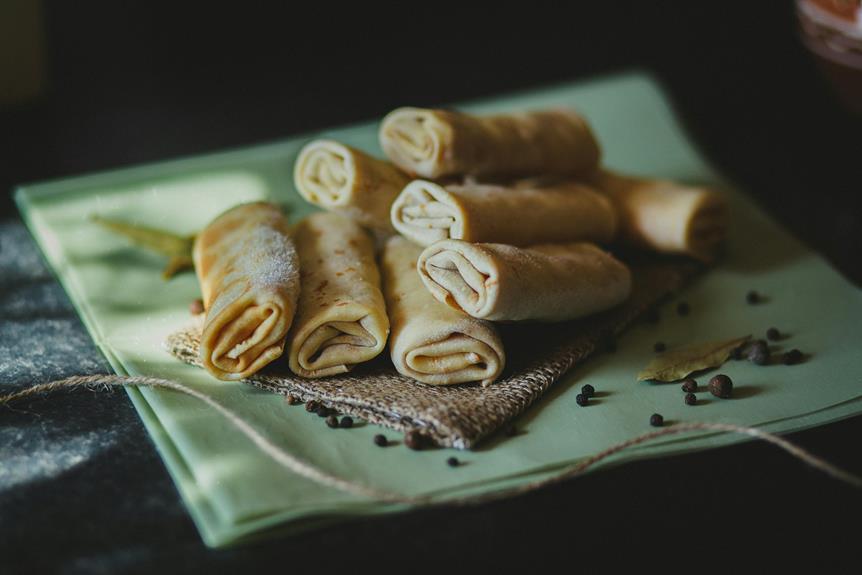When you're faced with the decision of choosing between Batiste and Crepe fabrics, it's essential to consider what you want from your garment. Batiste offers a lightweight, breathable feel perfect for casual summer outfits, while Crepe's structured drape lends itself to more formal attire. Each fabric has unique characteristics that could influence your final choice, but understanding their specific qualities can be the key to achieving the look and comfort you desire. So, what factors should you really prioritize when making this important decision?
Table of Contents
Overview of Batiste
Batiste is a lightweight, breathable fabric known for its soft texture and versatility in various clothing styles. You'll find it commonly used in garments like shirts, blouses, and dresses, making it a popular choice for warm weather. Its delicate feel and smooth finish give your outfits a touch of elegance, while its breathability ensures comfort throughout the day.
One of the standout features of batiste is its ability to drape beautifully. Whether you're crafting a flowing sundress or a tailored blouse, this fabric enhances the overall silhouette. Plus, batiste comes in various weights and can be blended with other fibers, offering you options for different occasions.
Care for batiste is straightforward; it's machine washable, though you might want to opt for a gentle cycle to maintain its quality. The fabric can also be easily ironed, allowing you to keep your garments looking crisp.
Overview of Crepe
Crepe is a unique fabric known for its distinct texture and drape.
You'll find it used in everything from elegant dresses to casual blouses.
Let's explore its characteristics, common applications, and how to care for it properly.
Fabric Characteristics
Crepe is known for its unique texture that offers a graceful drape and subtle stretch, making it a popular choice for elegant garments. This fabric features a crinkled or wrinkled surface, which adds visual interest and dimension. You'll find crepe available in various weights, from lightweight to heavy, allowing you to select the right type for your project.
When you touch crepe, you'll notice its soft and smooth feel, which enhances comfort while wearing. The natural elasticity of the fabric means it moves well with the body, providing ease of movement. Additionally, crepe resists wrinkles, so it maintains an impeccable appearance throughout the day.
The fabric can be made from various fibers, including silk, polyester, or rayon, influencing its overall look and feel. Silk crepe, for instance, showcases a luxurious finish, while synthetic blends offer durability and affordability.
Crepe also drapes beautifully, allowing it to fall gracefully over curves, making it ideal for flowing dresses and skirts. Overall, crepe combines elegance and functionality, ensuring you get the best of both worlds in your wardrobe.
Common Uses
You'll often find crepe in elegant dresses, flowing skirts, and sophisticated blouses, making it a favorite choice for formal occasions and stylish everyday wear. This versatile fabric drapes beautifully, enhancing your silhouette while providing comfort. You can easily dress it up for weddings or parties, or keep it casual for brunch with friends.
Crepe's unique texture adds visual interest to your outfits, setting it apart from more traditional fabrics. It also works well for tailored pieces, such as blazers and trousers, giving you a polished look without sacrificing ease. Plus, its lightweight quality makes it a go-to for warmer weather while retaining an air of sophistication.
In addition to clothing, crepe is popular for accessories like scarves and wraps, allowing you to incorporate this luxurious feel into your overall look. You might even find it in home décor items like curtains or tablecloths, adding a touch of elegance to your space.
Whether you're dressing for a special event or looking for chic everyday options, crepe's versatility and aesthetic appeal make it an excellent choice for your wardrobe.
Care Instructions
Caring for crepe fabric involves gentle washing and proper handling to maintain its luxurious appearance and texture.
When it comes to washing, it's best to hand wash your crepe items in cold water with a mild detergent. If you choose to machine wash, use a delicate cycle and a mesh laundry bag to protect the fabric. Avoid using bleach or harsh chemicals, as these can damage the fibers.
After washing, skip the spin cycle to prevent wrinkles. Instead, gently press out excess water and lay the fabric flat on a clean towel to dry. Avoid hanging, as this can stretch the crepe. When the fabric is slightly damp, you can iron it on a low setting, but always place a thin cloth between the iron and the crepe to prevent scorching.
Store your crepe garments in a cool, dry place, preferably hanging them on padded hangers to maintain their shape. Avoid folding, as crepe wrinkles easily.
With these care tips, you'll ensure your crepe remains beautiful and retains its elegant drape for years to come.
Key Characteristics of Batiste
Batiste is known for its lightweight, breathable texture that makes it an ideal choice for warm-weather garments. You'll love how it feels against your skin, providing comfort even in the hottest conditions. The fabric has a soft drape, giving your outfits an elegant flow that's perfect for dresses, blouses, and even linings.
Batiste typically comes in cotton or a cotton blend, offering durability while maintaining its delicate appearance. Its fine weaves create a smooth finish, which enhances the overall look of your creations. You'll also appreciate its crispness; it holds structure well, making it great for tailored pieces.
Another key characteristic is its versatility. You can easily dress up or down, making batiste suitable for both casual and formal wear. It's also easy to dye, allowing you to experiment with colors that suit your style.
Key Characteristics of Crepe
Crepe is characterized by its unique crinkled texture, which adds depth and interest to garments while providing a flattering silhouette. This fabric has several key characteristics that make it a popular choice for various clothing items.
Lightweight and breathable: Crepe is often made from materials like silk, polyester, or rayon, ensuring comfort and ease of movement.
Soft drape: The way crepe falls enhances the overall look of your outfit, making it perfect for dresses and blouses.
Wrinkle-resistant: Thanks to its textured surface, crepe tends to resist wrinkles, allowing you to maintain a polished appearance throughout the day.
Versatile: Crepe can be used for both casual and formal wear, adapting easily to different styles and occasions.
When you choose crepe, you're opting for a fabric that combines elegance with practicality. Its distinctive qualities not only elevate your wardrobe but also make it easy to incorporate into various outfits.
Whether you're dressing up for an event or opting for a more relaxed look, crepe's unique characteristics will surely enhance your style.
Best Uses for Each Fabric
When it comes to selecting the right fabric for your wardrobe, understanding the best uses for batiste and crepe can help you make informed choices for different occasions. Batiste is lightweight and breathable, making it perfect for warm weather. You'll find it ideal for summer dresses, blouses, and delicate sleepwear. Its soft drape gives a gentle flow, which feels comfortable against the skin.
On the other hand, crepe's unique texture and structure lend it a more formal feel. It's a fantastic choice for evening gowns, tailored suits, and professional attire. The fabric's ability to hold its shape makes it suitable for structured garments.
Here's a quick comparison to help you decide:
| Fabric | Best Uses | Ideal Occasions |
|---|---|---|
| Batiste | Summer dresses, blouses | Casual outings, vacations |
| Crepe | Evening gowns, suits | Formal events, office wear |
| Batiste | Nightwear | Relaxing at home |
| Crepe | Cocktail dresses | Parties, weddings |
| Batiste | Kids' clothing | Playdates, summer events |
How to Choose the Right Fabric
When choosing the right fabric, you need to consider the characteristics of batiste and crepe.
Think about what you'll use the fabric for, as each has its strengths and weaknesses.
Understanding these points will help you make an informed decision.
Fabric Characteristics Comparison
Choosing the right fabric involves understanding the unique characteristics of both batiste and crepe, as each offers distinct textures and drapes suitable for different projects.
Batiste is lightweight, soft, and often sheer, making it perfect for delicate garments or layering. On the other hand, crepe has a slightly crinkled texture that adds depth and sophistication to your designs.
When comparing these fabrics, consider the following characteristics:
- Drape: Batiste has a gentle, flowing drape, while crepe offers a more structured silhouette.
- Weight: Batiste is lightweight and airy, ideal for spring and summer wear. Crepe, while also lightweight, has a bit more body, making it suitable for year-round creations.
- Texture: Batiste is smooth and soft against the skin, while crepe has a unique texture that can enhance the visual appeal of your projects.
Intended Use Considerations
Understanding the intended use of your fabric can greatly influence your decision between batiste and crepe, as each is better suited for specific types of garments and occasions. If you're planning to create lightweight, breathable clothing, batiste is a fantastic choice. Its soft texture makes it ideal for delicate garments like blouses or baby clothes. On the other hand, crepe offers a bit more structure, making it perfect for dresses and skirts that need to hold their shape.
To help you decide, consider the following factors:
| Fabric Type | Best Uses |
|---|---|
| Batiste | Blouses, baby clothes, lingerie |
| Crepe | Dresses, skirts, formal wear |
| Batiste | Summer garments, lightweight |
| Crepe | Evening wear, structured pieces |
| Batiste | Quilting, soft drapes |
Ultimately, think about the look and feel you want to achieve. If you need something fluid and airy, go with batiste. If you prefer a more structured silhouette, crepe is your best bet. Choose wisely, and you'll create something beautiful!
Frequently Asked Questions
What Is the Origin of Batiste Fabric?
Batiste fabric originated in France during the 14th century, named after a French weaver. You'll find it's lightweight and soft, often made from cotton or linen, and perfect for delicate garments and linings.
Is Crepe Fabric Suitable for All Seasons?
Crepe fabric's lightweight and breathable nature makes it suitable for most seasons. In warmer months, its drape keeps you cool, while in cooler months, layering enhances warmth. You'll find it versatile for various occasions.
Can Batiste Be Machine Washed?
Yes, you can machine wash batiste, but make sure to use a gentle cycle with cold water. Avoid harsh detergents and high heat when drying to keep the fabric looking its best longer.
How Does the Price of Batiste Compare to Crepe?
When you compare prices, batiste typically costs less than crepe. However, prices can vary depending on quality and brand. Always check local retailers or online shops for the best deals on both fabrics.
Are There Any Eco-Friendly Options for Batiste or Crepe?
Yes, you can find eco-friendly options for both fabrics. Look for organic cotton batiste or recycled polyester crepe. These alternatives reduce environmental impact while maintaining quality and style, making them great choices for sustainable fashion.
- How Does Ring Spun Cotton Affect Garment Fit and Shape Retention? - August 13, 2024
- What Are the Challenges in Producing Ring Spun Cotton? - August 13, 2024
- Is Ring Spun Cotton Suitable for Plus-Size Clothing? - August 13, 2024







